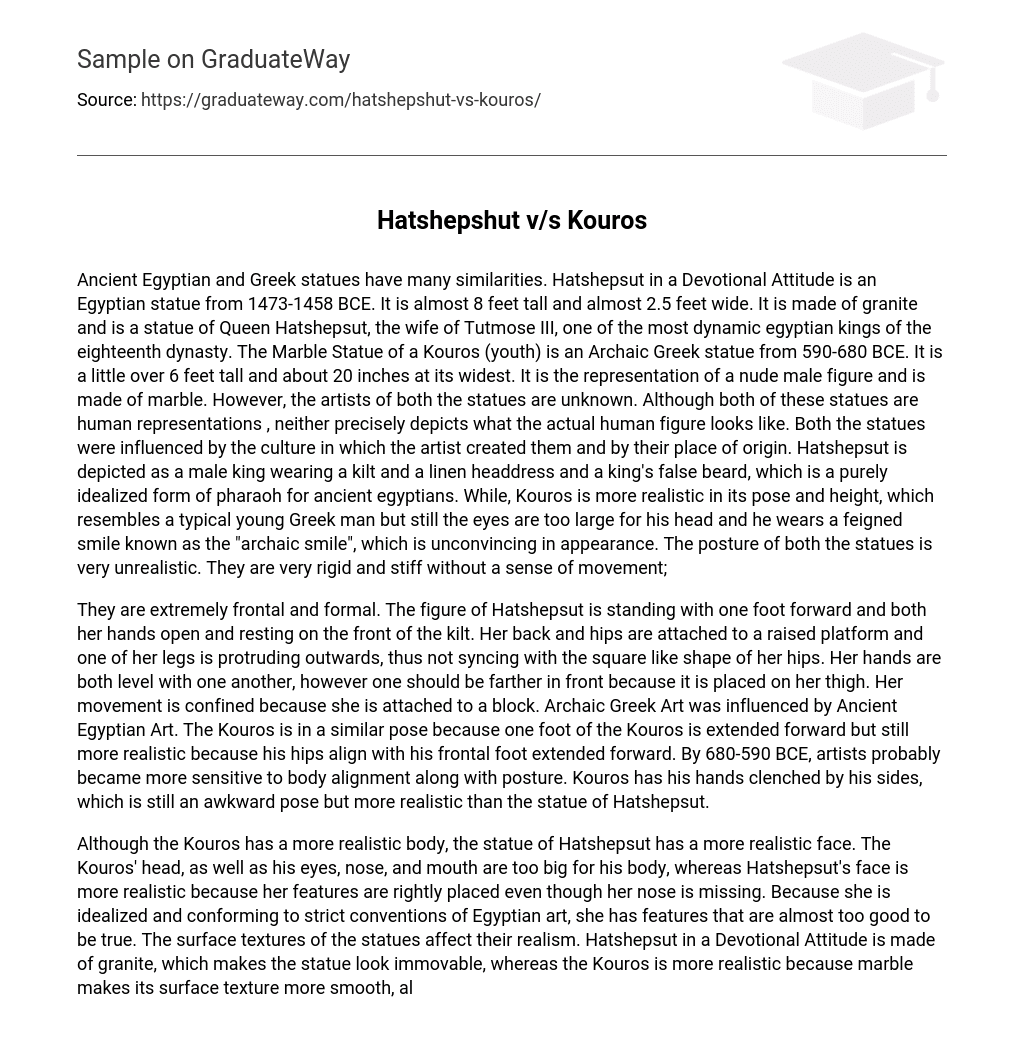Both the “Hatshepsut in a Devotional Attitude” and the “Marble Statue of a Kouros (youth)” share similarities despite being from different cultures and time periods. The Egyptian statue, created between 1473-1458 BCE, is made of granite, measures almost 8 feet tall and 2.5 feet wide, while the Greek statue from 590-680 BCE stands a little over 6 feet tall and is about 20 inches wide. Both statues depict human figures but do not accurately represent their true appearances. Hatshepsut is portrayed as a male king wearing traditional Egyptian attire, including a kilt, linen headdress, and false beard typically seen on pharaohs. In contrast, Kouros resembles a typical young Greek man in pose and height but has disproportionately large eyes for his head and wears an unnatural forced smile known as the “archaic smile.” Both statues display unrealistic postures without any sense of movement or fluidity.
The figure of Hatshepsut is formal and frontal, with one foot forward and both hands open and resting on the front of the kilt. Her back and hips are attached to a raised platform, causing her protruding leg to not align with the square shape of her hips. While her hands are level, one should be placed farther in front on her thigh. She is confined in movement due to being attached to a block. Ancient Egyptian Art influenced Archaic Greek Art. The Kouros shares a similar pose, with one foot extended forward, but his hips align with the forward foot, making it more realistic. Artists likely became more aware of body alignment and posture from 680-590 BCE. The Kouros clenches his hands by his sides, which, although still awkward, is more realistic than Hatshepsut’s statue.
Despite their differences in realism, both the Kouros and the statue of Hatshepsut conform to the artistic conventions of their respective cultures. The Kouros displays a more idealized body but has exaggerated features such as an oversized head, eyes, nose, and mouth. On the other hand, Hatshepsut’s face is more realistic with well-placed features, even though her nose is missing. Her statue portrays an idealized version of herself, following strict Egyptian art conventions. The choice of materials also affects the statues’ realism. Hatshepsut in a Devotional Attitude is made of granite, giving it an immovable appearance. In contrast, the Kouros looks more realistic due to the smooth marble surface texture resembling skin. The use of red and black granite in Hatshepsut’s statue represents her as distinct from common women of her time and suggests an inaccessible stature. In comparison, the Kouros appears more lifelike and approachable, representing a common Greek man. These stylistic depictions reflect the concerns and thinking of their respective cultures. Hatshepsut is portrayed as a pharaoh, highlighting the Egyptians’ focus on the afterlife and preparation for it. In contrast, the Kouros symbolizes humanism and earthly life, representing a shift in Greek thinking. Additionally, Hathepsut’s pose is inspired by earlier Egyptian statues.The Kouros statue’s anatomy resembles that of most other Egyptian statues as they followed a standardized formula for body proportions during the carving process. Similarly, other Kouros statues also depict the figure in a nude and freestanding position with one leg positioned forward.
The Kouros statue is characterized by its large, wide-open eyes and archaic smile. In contrast, the Hatshepsut statue focuses more on the overall appearance of an idol figure rather than individual muscles. The Marble Statue of Kouros emphasizes the muscular shapes of its arms and legs, creating a more realistic depiction. Throughout the archaic and classical period, the Greeks continuously created nude human statues in an effort to portray a sense of reality. This marks a significant transition from representing the unknown or idealized (Hatshepsut) to representing what is known and real (Kouros) over a span of 500-1000 years. The artist of the Hatshepsut statue likely aimed to convey power and timelessness through the frontal gaze and formal posture, while the artist of the Kouros statue focused on depicting an almost precise human figure as a representation of evolution and change. In comparison, the Egyptians were more unwilling to break conventional norms and had a rigid view of their glorified rulers, whereas the Greeks constantly challenged conventions in their portrayal of human forms.
The Greeks were moving towards realism and striving to depict what is known as the human form. Notably, the statue of Hatshepsut is presented as a young man, following an established formula for statue carving. This formula was used to represent all types of pharaohs, regardless of their gender, resulting in none of them truly resembling their portraits. Similarly, the Kouroi, used as gravestones, also don’t bear resemblance to the individuals they represent. Most of them depict gods and warriors. Although some elements of these statues resemble humans, they are not accurate representations. “Hatshepsut in a Devotional Attitude” shows appropriate features but appears formulaic as it portrays her as an ideal king rather than an ordinary woman. On the other hand, the Marble Statue of a Kouros exhibits anatomically correct body parts but is still disproportionate. Nevertheless, the Kouros is more realistic of the two, standing on its own and having a more lifelike appearance.





